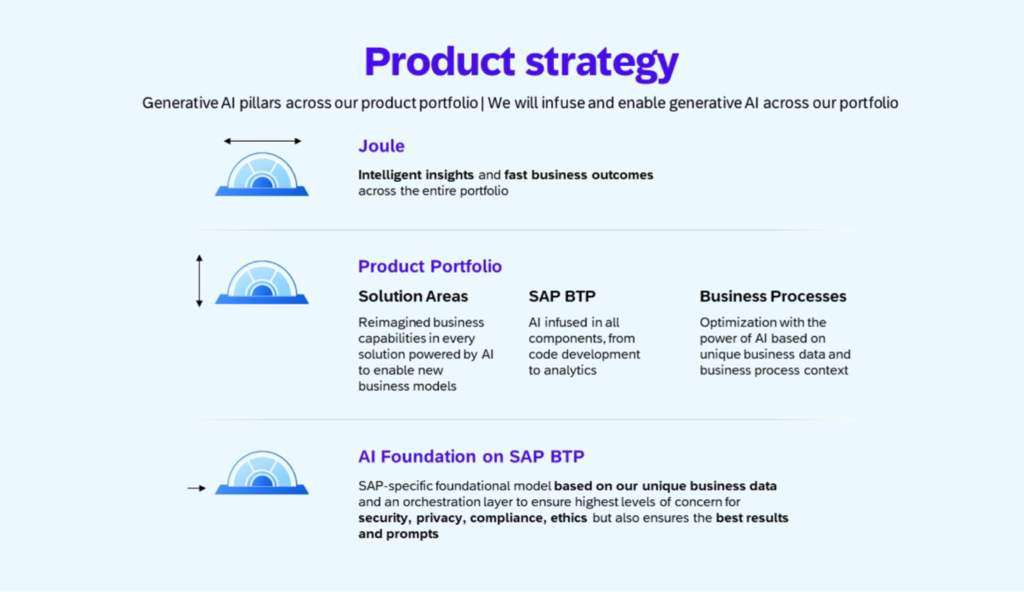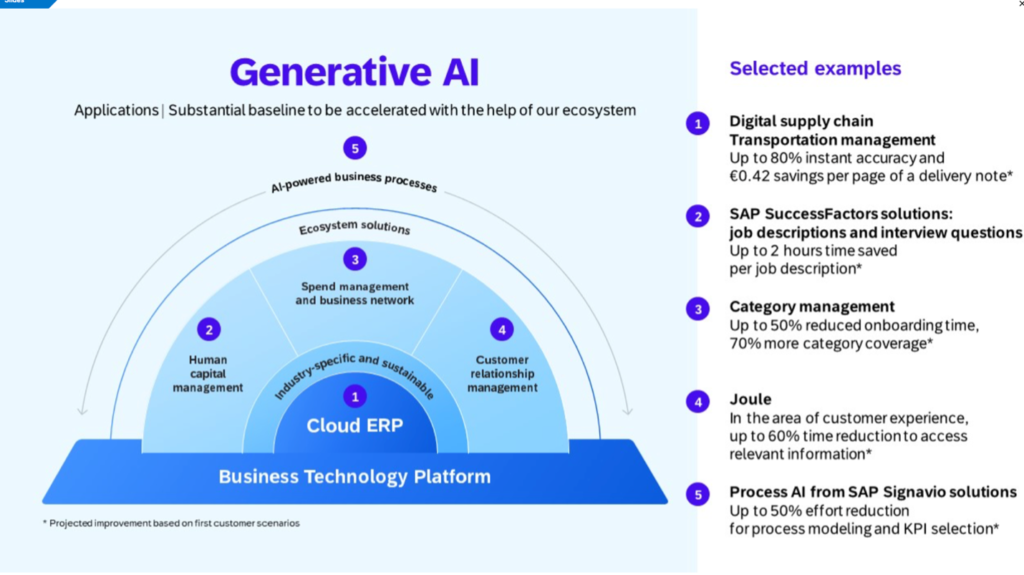The News
A lot is going on in the SAPverse during October and the early days of November 2023. First, SAP conducted its CXLive event with CX-related announcements, then the company reported good Q3/2023 figures, a new version of its CX software that includes new generative AI capabilities got released and lastly, it executed its SAP TechEd event with a good number of AI-, BTP-, and ERP related announcements.
As this is quite a lot, I covered the CX world in a previous post and will cover the TechEd related news in this post.
So, what is new at SAP TechEd? For one, it is enough to fill a 17-page pre-event news guide that SAP sent out. SAP certainly is able to stack up the news for major events. I took the liberty to ask ChatGPT for a summary of the document, which I slightly edited afterwards. Here we are:
AI and Development Environments:
- SAP introduces SAP Build Code with generative AI, improving application development and testing, while new AI capabilities are integrated across SAP’s ecosystem to drive automation.
Business Technology Platform (BTP):
- BTP is augmented with new guides for application deployment and makes the SAP Cloud SDK for Java open source.
- A new vector capability for managing unstructured data via high-dimensional vectors is announced as part of SAP HANA, enhancing developer productivity, and allowing for Retrieval Augmented Generation (RAG) that combines large language models with business data.
- SAP Graph is generally available, and now extends API management to offer a unified API for streamlined access to enterprise data, boosting productivity and integration efforts.
Cloud ERP:
- SAP introduces new features to facilitate cloud adoption, including a parallel project line for SAP S/4HANA Cloud and a rewards program for maintaining a clean ERP core.
Learning Services and Support:
- New certifications and learning resources are launched, especially for ABAP Cloud back-end development, alongside support services for RISE with SAP.
SAP Datasphere:
- SAP Datasphere is set to release enhanced capabilities for semantic onboarding, allowing organizations to integrate business data while maintaining business context. This includes importing entities from various source systems and providing simplified data sharing and prebuilt business content for data and analytics projects.
According to ChatGPT, “these updates underscore SAP’s commitment to leveraging AI and offering robust tools and services to enhance developer experiences, optimize data management, and support businesses in their digital transformation journeys.”
The bigger picture
Like every other company, too, SAP has jumped on the generative AI train. For some time now, we are hearing of a lot of announcements and available functionality. This includes co-pilots as well as own foundation models or at least LLMs everywhere.
With all these, SAP is in tough competition. On the other hand, SAP is one of the very few – if not the only – companies that has the ability to cover the complete enterprise value chain with its software. It, indeed, looks at covering the value chain of complete industries with a vast variety of products and solutions.
One of the core problems that many vendors do have is that their product stack is a result of a number of acquisitions. Hence, the products and solutions base on different technologies and technology stacks. On top of that, different units often operate on different priorities, as tactics and opportunities vary. This makes it very hard to come forward with one coherent set of solutions. The necessary need for coordination may also make a company appear as slow in innovation.
My analysis and point of view
For the fun of it, let’s start with ChatGPT’s take on the announcements before I give you mine
“Overall, SAP’s announcements focus on leveraging generative AI to supercharge development, modernize heterogeneous environments, harness the power of intelligent data applications, and provide foundational AI solutions for businesses. Additionally, SAP continues to evolve its BTP with new resources and support services, fostering a more agile and efficient business environment. The announcements also highlight SAP’s commitment to learning and development for developers, emphasizing their pivotal role in the era of AI.”
SAP certainly let loose a flurry of announcements. TechEd being TechEd, a lot was about technology, in particular about how AI can improve all business processes from the creation of solutions through their delivery and their use.

Three-tiered SAP AI strategy; source SAP
This bases on a clear three-tiered architecture, supported by a strong ecosystem. The architecture shall overcome the two main challenges that SAP’s Chief of AI, Walter Sun, cites, namely the old training state of LLMs and the systems inherent inability to know specifics of the company.
Especially the ability of Joule to tap into external LLMs, external as well as SAP data – and in future also foundation model – has the potential to transform how users use applications and how businesses can improve their processes, especially considering the assets SAP has with Signavio and LeanIX. It is clear that SAP invests a lot into making strong AI capabilities available as a service to business applications, mainly via its new copilot, Joule. This certainly takes care of the relevant and reliable keywords that SAP uses in its messaging. The enhancements of SAP HANA to support vector storages is an additional precondition for this. The same holds true for Datasphere as the means for classification, organization and understanding of data. The value of this cannot be understated with SAP systems always being part of an ecosystem and SAP systems themselves not working on the same database instances or having a common physical data model.
The keyword “responsible” is a bit more difficult, though. SAP has a strong AI ethics policy and a corresponding AI ethics handbook. These lay out how SAP treats AI from an internal procedural level. SAP also trains its business AI only using anonymized data of customers that actively gave their consent. And more than 25 thousand customers gave this consent. This is testament to the trust in SAP’s responsible conduct and will help with relevance and reliability. While I do trust SAP, too, I think that it would be beneficial to also add information around how SAP makes sure on a technology level that customer data is kept secure and private when exchanging data with external systems, in particular AIs in the public cloud.
The tight integration of the SAP development environments from low code through pro code is important. The integration of Joule into SAP Build Code to speed up development processes is the icing of the cake.
What SAP delivered so far is a good way ahead on a road. Naturally, not everything is available yet, much is on the roadmap. A caution is necessary when it comes to SAP’s analytics cloud (SAC). As I understood the briefing and the part of the business application keynote about SAC during SAP TechEd, SAC does not (yet?) leverage this platform. It has its own low code development environment. Additionally, SAC uses a feature “Just Ask” that “complements Joule”. This I understand as Just Ask not using Joule.
Although this might be a temporary solution, the caution is that temporary solutions tend to become permanent.
On the positive side, it is obvious that SAP has deployed AI solutions across the value chain and can show strong outcomes.

Benefits of generative AI in business scenarios across the value chain; source: SAP
These outcomes have been showcased on numerous levels, so SAP clearly doesn’t only talk but also walks the talk and delivers across applications. A particularly interesting scenario was the clean core scenario using Signavio to identify custom code that can get removed. Imagine a scenario like this being extended to the system automatically adapting the code, testing it and offer it as a ready-made solution. I’d be thrilled to see something like this as a next step. This could help speeding up migrations from ECC6 to S/4HANA considerably while reducing cost. The consulting market doesn’t have the capacity that is needed for mass migrations, anyways.
The one thing where I advise some caution is SuccessFactors. While SAP showed an interesting case, I wonder how far we want to go as a business – or as a society – reducing people to numbers. The scenario is about skills, aka “having done it before” instead of talent, aka “being able to do it”.
Being a CX guy, I found it satisfying that there have been several references to SAP’s CX division, starting from above image, going on with a Retail Execution scenario, having Michael Nilles, Henkel’s Chief Digital and Information Officer talk about Trade Promotion Management on BTP with SAP and CX and Industry President Ritu Bhargava being part of the keynote. Adding on to the statements made by Christian Klein during the CX Live Keynote, this adds credibility to SAP being serious about CX.
All in all, I see SAP laying a strong technology foundation for innovative business applications that can deliver a lot of value to businesses, employees, and customers. Some portions of the messaging as well as the delivery could be somewhat refined or sharpened, though.
Still, it is clearly visible that SAP is on a strong path. I am already excited to see what Sapphire 2024 has in store.

